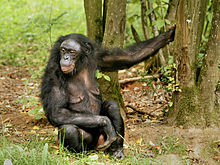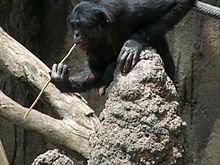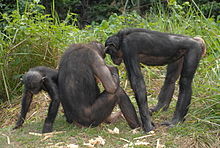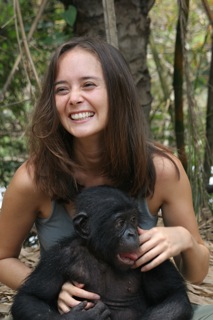
Bonobo
Did you know...
This content from Wikipedia has been selected by SOS Children for suitability in schools around the world. Click here to find out about child sponsorship.
| Bonobo Temporal range: 1.5–0Ma |
|
|---|---|
 |
|
| Bonobos at the Cincinnati Zoo | |
| Conservation status | |
 Endangered ( IUCN 3.1) |
|
| Scientific classification | |
| Kingdom: | Animalia |
| Phylum: | Chordata |
| Class: | Mammalia |
| Order: | Primates |
| Family: | Hominidae |
| Tribe: | Panini |
| Genus: | Pan |
| Species: | P. paniscus |
| Binomial name | |
| Pan paniscus Schwarz, 1929 |
|
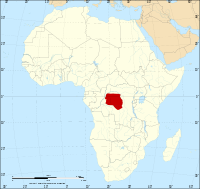 |
|
| Bonobo distribution | |
The bonobo ( / b ə ˈ n oʊ b oʊ / or / ˈ b ɒ n ə b oʊ /), Pan paniscus, previously called the pygmy chimpanzee and less often, the dwarf or gracile chimpanzee, is a great ape and one of the two species making up the genus Pan; the other is Pan troglodytes, or the common chimpanzee. Although the name "chimpanzee" is sometimes used to refer to both species together, it is usually understood as referring to the common chimpanzee, while Pan paniscus is usually referred to as the bonobo.
It is distinguished by relatively long legs, pink lips, dark face and tail-tuft through adulthood, and parted long hair on its head. The bonobo is found in a 500,000 km2 (190,000 sq mi) area of the Congo Basin in the Democratic Republic of the Congo, Central Africa. The species is omnivorous and inhabits primary and secondary forests, including seasonally inundated swamp forests.
The bonobo is popularly known for its high levels of sexual behaviour. Sex functions in conflict appeasement, affection, social status, excitement, and stress reduction. It occurs in virtually all partner combinations and in a variety of positions. This is a factor in the lower levels of aggression seen in the bonobo when compared to the common chimpanzee and other apes. Bonobos are perceived to be matriarchal; females tend to collectively dominate males by forming alliances and use sexuality to control males. A male's rank in the social hierarchy is often determined by his mother's rank.
Along with the common chimpanzee, the bonobo is the closest extant relative to humans. Because the two species are not proficient swimmers, the formation of the Congo River 1.5–2 million years ago possibly led to the speciation of the bonobo. They live south of the river, and thereby were separated from the ancestors of the common chimpanzee, which live north of the river. There are no concrete data on population numbers, but the estimate is between 29,500 and 50,000 individuals. The species is listed as Endangered on the IUCN Red List and is threatened by habitat destruction and human population growth and movement, though commercial poaching is the most prominent threat. It typically lives 40 years in captivity, though its lifespan in the wild is unknown.
Etymology
Despite the alternative common name "pygmy chimpanzee", the bonobo is not especially diminutive when compared to the common chimpanzee. "Pygmy" may instead refer to the pygmy peoples who live in the same area. The name "bonobo" first appeared in 1954, when Tratz and Heck proposed it as a new and separate generic term for pygmy chimpanzees. The name is thought to be a misspelling on a shipping crate from the town of Bolobo on the Congo River, which was associated with the collection of chimps in the 1920s. The term has also been reported as being a word for "ancestor" in an extinct Bantu language.
Evolutionary history
Fossils
Fossils of Pan species were not described until 2005. Existing chimpanzee populations in West and Central Africa do not overlap with the major human fossil sites in East Africa. However, Pan fossils have now been reported from Kenya. This would indicate that both humans and members of the Pan clade were present in the East African Rift Valley during the Middle Pleistocene. According to A. Zihlman bonobo body proportions closely resemble those of Australopithecus.
Taxonomy and phylogeny
German anatomist Ernst Schwarz is credited with having discovered the bonobo in 1928, based on his analysis of a skull in the Tervuren museum in Belgium that previously had been thought to have belonged to a juvenile chimpanzee. Schwarz published his findings in 1929. In 1933, American anatomist Harold Coolidge offered a more detailed description of the bonobo, and elevated it to species status. The American psychologist and primatologist Robert Yerkes was also one of the first scientists to notice major differences between bonobos and chimpanzees. These were first discussed in detail in a study by Eduard Paul Tratz and Heinz Heck published in the early 1950s.
A first official publication of sequencing and assembly of the bonobo genome is publicly available as of June 2012 deposited with the International Nucleotide Sequence Database Collaboration (DDBJ/EMBL/GenBank) under the EMBL accession number AJFE01000000. After a previous initial analysis by the National Human Genome Research Institute confirmed that the bonobo genome is about 0.4% divergent from the chimpanzee genome. In addition, Svante Pääbo's group at the Max Planck Institute for Evolutionary Anthropology is currently sequencing the genome of a female bonobo from the Leipzig zoo.
Initial genetic studies characterised the DNA of chimpanzees and bonobos as being as much as 98% (99.4% in one study) identical to that of Homo sapiens. Later studies showed that chimpanzees and bonobos are more closely related to humans than to gorillas. In the crucial Nature paper reporting on initial genome comparisons, researchers identified 35 million single-nucleotide changes, five million insertion or deletion events, and a number of chromosomal rearrangements which constituted the genetic differences between the two Pan species and humans, covering 98% of the same genes. While many of these analyses have been performed on the common chimpanzee rather than the bonobo, the differences between the two Pan species are unlikely to be substantial enough to affect the Pan-Homo comparison significantly.
There still is controversy, however. Scientists such as Jared Diamond in The Third Chimpanzee, and Morris Goodman of Wayne State University in Detroit suggest that the bonobo and common chimpanzee are so closely related to humans that their genus name also should be classified with the human genus Homo: Homo paniscus, Homo sylvestris, or Homo arboreus. An alternative philosophy suggests that the term Homo sapiens is the misnomer rather, and that humans should be reclassified as Pan sapiens, though this would violate the Principle of Priority, as Homo was named before Pan (1758 for the former, 1816 for the latter). In either case, a name change of the genus would have implications on the taxonomy of extinct species closely related to humans, including Australopithecus. The current line between Homo and non-Homo species is drawn about 2.5 million years ago, and chimpanzee and human ancestry converges only about 7 million years ago, nearly three times longer ago.
DNA evidence suggests the bonobo and common chimpanzee species effectively separated from each other fewer than one million years ago. The Pan line split from the last common ancestor shared with humans approximately six to seven million years ago. Because no species other than Homo sapiens has survived from the human line of that branching, both Pan species are the closest living relatives of humans and cladistically are equally close to humans. The recent genome data confirms the genetic equidistance.
Physical description
The bonobo is commonly considered to be more gracile than the common chimpanzee. Although large male chimpanzees can exceed any bonobo in bulk and weight, the two species actually broadly overlap in body size. Adult female bonobos are somewhat smaller than adult males. Body mass in males ranges from 34 to 60 kg (75 to 130 lb), against an average of 30 kg (66 lb) in females. The total length of bonobos (from the nose to the rump while on all fours) is 70 to 83 cm (28 to 33 in). When adult bonobos and chimpanzees stand up on their legs, they can both attain a height of 115 cm (45 in). Its head is relatively smaller than that of the common chimpanzee with less prominent brow ridges above the eyes. It has a black face with pink lips, small ears, wide nostrils, and long hair on its head that forms a part. Females have slightly more prominent breasts, in contrast to the flat breasts of other female apes, although not so prominent as those of humans. The bonobo also has a slim upper body, narrow shoulders, thin neck, and long legs when compared to the common chimpanzee.
Bonobos are both terrestrial and arboreal. Most ground locomotion is characterized by quadrupedal knuckle walking. Bipedal walking has been recorded as less than 1% of terrestrial locomotion in the wild, a figure that decreased with habituation, while in captivity there is a wide variation. Bipedal walking in captivity, as a percentage of bipedal plus quadrupedal locomotion bouts, has been observed from 3.9% for spontaneous bouts to nearly 19% when abundant food is provided. These physical characteristics and its posture give the bonobo an appearance more closely resembling that of humans than that of the common chimpanzee. The bonobo also has highly individuated facial features, as humans do, so that one individual may look significantly different from another, a characteristic adapted for visual facial recognition in social interaction.
Multivariate analysis has shown bonobos are more neotenized than the common chimpanzee, taking into account such features as the proportionately long torso length of the bonobo. Other researchers challenged this conclusion.
Behaviour
Primatologist Frans de Waal states bonobos are capable of altruism, compassion, empathy, kindness, patience, and sensitivity. However, some have disputed how peaceful bonobos are.
Social behaviour
Most studies indicate that females have a higher social status in bonobo society. Aggressive encounters between males and females are rare, and males are tolerant of infants and juveniles. A male derives his status from the status of his mother. The mother–son bond often stays strong and continues throughout life. While social hierarchies do exist, rank plays a less prominent role than in other primate societies.
The limited research on bonobos in the wild was taken to indicate that these matriarchal behaviors may be exaggerated by captivity, as well as by food provisioning by researchers in the field.
Bonobo party size tends to vary because the groups exhibit a fission–fusion pattern. A community of approximately 100 will split into small groups during the day while looking for food, and then will come back together to sleep. They sleep in nests that they construct in trees.
Sexual social behaviour
Sexual intercourse plays a major role in bonobo society, being used as what some scientists perceive as a greeting, a means of forming social bonds, a means of conflict resolution, and postconflict reconciliation. Bonobos are the only nonhuman animal to have been observed engaging in all of the following sexual activities: face-to-face genital sex (although a pair of western gorillas has been photographed performing face-to-face genital sex,) tongue kissing, and oral sex. In scientific literature, the female–female behaviour of pressing genitals together is often referred to as GG rubbing or genito–genital rubbing. The sexual activity happens within the immediate community and sometimes outside of it. Bonobos do not form permanent monogamous sexual relationships with individual partners. They also do not seem to discriminate in their sexual behaviour by sex or age, with the possible exception of abstaining from sexual intercourse between mothers and their adult sons. When bonobos come upon a new food source or feeding ground, the increased excitement will usually lead to communal sexual activity, presumably decreasing tension and encouraging peaceful feeding.
Bonobo males occasionally engage in various forms of male–male genital behaviour. In one form, two males hang from a tree limb face-to-face while " penis fencing". This also may occur when two males rub their penises together while in face-to-face position. Another form of genital interaction ("rump rubbing") occurs to express reconciliation between two males after a conflict, when they stand back-to-back and rub their scrotal sacs together. Takayoshi Kano observed similar practices among bonobos in the natural habitat.
But more often than the males, female bonobos engage in mutual genital behaviour, possibly to bond socially with each other, thus forming a female nucleus of bonobo society. The bonding among females enables them to dominate most of the males. Although male bonobos are individually stronger, they cannot stand alone against a united group of females. Adolescent females often leave their native community to join another community. Sexual bonding with other females establishes these new females as members of the group. This migration mixes the bonobo gene pools, providing genetic diversity.
Bonobo reproductive rates are no higher than those of the common chimpanzee. During oestrus, females undergo a swelling of the perineal tissue lasting 10 to 20 days. Most matings occur during the maximum swelling. The gestation period is on average 240 days. Postpartum amenorrhea (absence of menstruation) lasts less than one year and a female may resume external signs of oestrus within a year of giving birth, though the female is probably not fertile at this point. Female bonobos carry and nurse their young for four years and give birth on average every 4.6 years. Compared to common chimpanzees, bonobo females resume the genital swelling cycle much sooner after giving birth, enabling them to rejoin the sexual activities of their society. Also, bonobo females which are sterile or too young to reproduce still engage in sexual activity. The lifespan of a bonobo in captivity is about 40 years. The lifespan in the wild is unknown.
How bonobos avoid SIV and its effects are unknown.
Diet
The bonobo is an omnivorous frugivore. The majority of its diet is fruit, but supplements its diet with leaves, meat from small vertebrates such as anomalures, flying squirrels and duikers, and invertebrates. In some instances, bonobos have been shown to consume lower-order primates. Some claim bonobos have also been known to practise cannibalism in captivity, a claim disputed by others. However, at least one confirmed report of cannibalism in the wild of a deceased infant was reported by researchers Gottfried Hohmann and Andrew Fowler in 2008.
Peacefulness
Observations in the wild indicate that the males among the related common chimpanzee communities are extraordinarily hostile to males from outside the community. Parties of males 'patrol' for the unfortunate neighbouring males that might be travelling alone, and attack those single males, often killing them. This does not appear to be the behaviour of bonobo males or females in their own communities, where they seem to prefer sexual contact over violent confrontation with outsiders. In fact, the Japanese scientists who have spent the most time working with wild bonobos describe the species as extraordinarily peaceful, and De Waal has documented how bonobos may often resolve conflicts with sexual contact (hence the " make love, not war" characterization for the species). Between groups, social mingling may occur, in which members of different communities have sex and groom each other, behaviour which is unheard of among common chimpanzees. Conflict is still possible between rival groups of bonobos, but no official scientific reports of it exist. The ranges of bonobos and chimpanzees are separated by the Congo River, with bonobos living to the south of it, and chimpanzees to the north. It has been hypothesised that bonobos are able to live a more peaceful lifestyle in part because of an abundance of nutritious vegetation in their natural habitat, allowing them to travel and forage in large parties.
Recent studies shows that there are significant brain differences between bonobos and chimps. The brain anatomy of a bonobo have more developed and larger regions assumed to be vital for feeling empathy, sensing distress in others and feeling anxiety, which makes them less aggressive and more empathic than their close relatives. They also have a thick connection between the amygdala, an important area that can spark aggression, and the ventral anterior cingulate cortex, which helps control impulses. This thicker connection makes them better in regulating their emotional impulses and behaviour.
The popular image of the bonobo as a peaceful ape does not always apply to captive populations. Accounts exist of bonobos confined in zoos mutilating one another and engaging in bullying. These incidents may be due to the practice in zoos of separating mothers and sons, which is contrary to their social organization in the wild. Bonobo society is dominated by females, and severing the lifelong alliance between mothers and their male offspring may make them vulnerable to female aggression. De Waal has warned of the danger of romanticizing bonobos: "All animals are competitive by nature and cooperative only under specific circumstances" and that "when first writing about their behaviour, I spoke of 'sex for peace' precisely because bonobos had plenty of conflicts. There would obviously be no need for peacemaking if they lived in perfect harmony." It remains important to note, however, that in contrast to the many observations of lethal aggression among chimpanzees, there are no such eyewitness accounts for bonobos, neither in captivity nor in the wild.
In the discussion about peacefulness, it is sometimes brought up how bonobos kill monkeys, but for the biologist this falls in a totally different category, since predation is driven by hunger, not aggression. Hohmann and Surbeck published in 2008 that bonobos sometimes do hunt monkey species. Five incidents were observed in a group of bonobos in Salonga National Park, which seemed to reflect deliberate cooperative hunting. On three occasions, the hunt was successful and infant monkeys were captured.
Similarity to humans
Bonobos are capable of passing the mirror-recognition test for self-awareness. They communicate primarily through vocal means, although the meanings of their vocalizations are not currently known. However, most humans do understand their facial expressions and some of their natural hand gestures, such as their invitation to play. Two bonobos at the Great Ape Trust, Kanzi and Panbanisha, have been taught how to communicate using a keyboard labeled with lexigrams (geometric symbols) and they can respond to spoken sentences. Kanzi's vocabulary consists of more than 500 English words and he has comprehension of around 3,000 spoken English words. Kanzi is also known for learning by observing people trying to teach his mother; Kanzi started doing the tasks that his mother was taught just by watching, some of which his mother had failed to learn. Some, such as philosopher and bioethicist Peter Singer, argue that these results qualify them for " rights to survival and life" — rights that humans theoretically accord to all persons. (See great Ape personhood.)
Instances in which nonhuman primates have expressed joy have been reported. One study analyzed and recorded sounds made by human babies and bonobos when they were tickled. Although the bonobos' laugh was a higher frequency, the laugh was found to follow a similar spectrographic pattern to that of human babies.
Habitat and distribution
Bonobos are found only south of the Congo River and north of the Kasai River (a tributary of the Congo), in the humid forests of the Democratic Republic of Congo of central Africa. Ernst Schwarz's 1927 paper “Le Chimpanzé de la Rive Gauche du Congo”, announcing his discovery, has been read as an association between the Parisian Left Bank and the left bank of the Congo River; the bohemian culture in Paris, and an unconventional ape in the Congo.
Conservation status
The IUCN Red List classifies bonobos as an endangered species, with conservative population estimates ranging from 29,500 to 50,000 individuals. Major threats to bonobo populations include habitat loss and hunting for bushmeat, the latter activity having increased dramatically during the first and second Congo wars in the Democratic Republic of Congo due to the presence of heavily armed militias even in remote "protected" areas such as Salonga National Park. This is part of a more general trend of ape extinction.
As the bonobos' habitat is shared with people, the ultimate success of conservation efforts will rely on local and community involvement. The issue of parks versus people is salient in the Cuvette Centrale the bonobos' range. There is strong local and broad-based Congolese resistance to establishing national parks, as indigenous communities have often been driven from their forest homes by the establishment of parks. In Salonga National Park, the only national park in the bonobo habitat, there is no local involvement, and surveys undertaken since 2000 indicate the bonobo, the African forest elephant, and other species have been severely devastated by poachers and the thriving bushmeat trade. In contrast, areas exist where the bonobo and biodiversity still thrive without any established parks, due to the indigenous beliefs and taboos against killing bonobos.
The port town of Basankusu is situated on the Lulonga River, at the confluence of the Lopori and Maringa Rivers, in the north of the country, making it well placed to receive and transport local goods to the cities of Mbandaka and Kinshasa. With Basankusu being the last port of substance before the wilderness of the Lopori Basin and the Lomako River—–the bonobo heartland—conservation efforts for the bonobo use the town as a base.
In 1995, concern over declining numbers of bonobos in the wild led the Zoological Society of Milwaukee, in Milwaukee, Wisconsin, with contributions from bonobo scientists around the world, to publish the Action Plan for Pan paniscus: A Report on Free Ranging Populations and Proposals for their Preservation. The Action Plan compiles population data on bonobos from 20 years of research conducted at various sites throughout the bonobo's range. The plan identifies priority actions for bonobo conservation and serves as a reference for developing conservation programs for researchers, government officials, and donor agencies.
Acting on Action Plan recommendations, the ZSM developed the Bonobo and Congo Biodiversity Initiative. This program includes habitat and rain-forest preservation, training for Congolese nationals and conservation institutions, wildlife population assessment and monitoring, and education. The Zoological Society has conducted regional surveys within the range of the bonobo in conjunction with training Congolese researchers in survey methodology and biodiversity monitoring. The Zoological Society’s initial goal was to survey Salonga National Park to determine the conservation status of the bonobo within the park and to provide financial and technical assistance to strengthen park protection. As the project has developed, the Zoological Society has become more involved in helping the Congolese living in bonobo habitat. The Zoological Society has built schools, hired teachers, provided some medicines, and started an agriculture project to help the Congolese learn to grow crops and depend less on hunting wild animals.
During the wars in the 1990s, researchers and international non-governmental organizations (NGOs) were driven out of the bonobo habitat. In 2002, the Bonobo Conservation Initiative initiated the Bonobo Peace Forest Project supported by the Global Conservation Fund of Conservation International and in cooperation with national institutions, local NGOs, and local communities. The Peace Forest Project works with local communities to establish a linked constellation of community-based reserves, managed by local and indigenous people. Although there has been only limited support from international organizations, this model, implemented mainly through DRC organizations and local communities, has helped bring about agreements to protect over 5,000 square miles (13,000 km2) of the bonobo habitat. According to Dr. Amy Parish, the Bonobo Peace Forest "is going to be a model for conservation in the 21st century."
With grants from the United Nations, USAID, the U.S. Embassy, the World Wildlife Fund, and many other groups and individuals, the Zoological Society also has been working to:
- Survey the bonobo population and its habitat to find ways to help protect these apes
- Develop antipoaching measures to help save apes, forest elephants, and other endangered animals in Congo's Salonga National Park, a UN World Heritage site
- Provide training, literacy education, agricultural techniques, schools, equipment, and jobs for Congolese living near bonobo habitats so that they will have a vested interest in protecting the great apes – the ZSM started an agriculture project to help the Congolese learn to grow crops and depend less on hunting wild animals.
- Model small-scale conservation methods that can be used throughout Congo
Starting in 2003, the U.S. government allocated $54 million to the Congo Basin Forest Partnership. This significant investment has triggered the involvement of international NGOs to establish bases in the region and work to develop bonobo conservation programs. This initiative should improve the likelihood of bonobo survival, but its success still may depend upon building greater involvement and capability in local and indigenous communities.
The Congo is setting aside more than 11,000 square miles (28,000 km2) of rain forest to help protect the endangered bonobo, in this central African country. U.S. agencies, conservation groups, and the Congolese government have come together to set aside 11,803 square miles (30,570 km2) of tropical rain forest, the U.S.-based Bonobo Conservation Initiative. The area amounts to just over 1% of the vast Congo – but that means a park larger than the state of Massachusetts.
The bonobo population is believed to have declined sharply in the last 30 years, though surveys have been hard to carry out in war-ravaged central Congo. Estimates range from 60,000 to fewer than 50,000 living, according to the World Wildlife Fund.
In addition, concerned parties have addressed the crisis on several science and ecological websites. Organizations such as the World Wide Fund for Nature, the African Wildlife Foundation, and others, are trying to focus attention on the extreme risk to the species. Some have suggested that a reserve be established in a more stable part of Africa, or on an island in a place such as Indonesia. Awareness is ever increasing, and even nonscientific or ecological sites have created various groups to collect donations to help with the conservation of this species.
